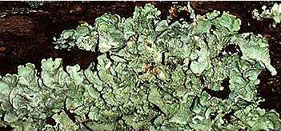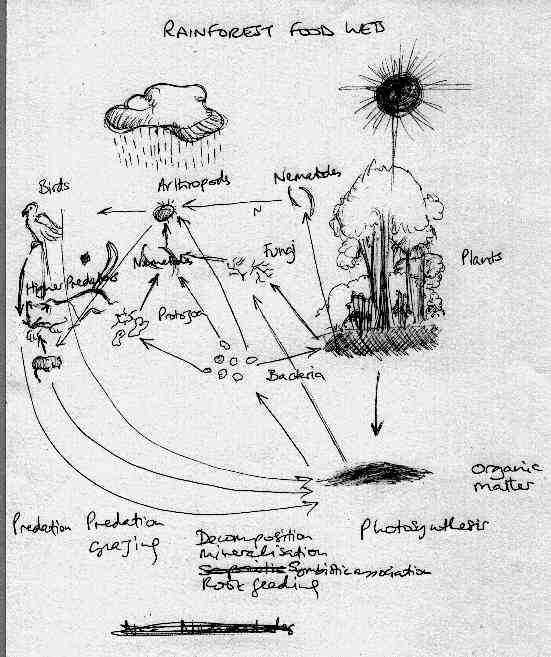




What is Microbiology?
|
Have
you ever wondered about how small germs are?
|
|
The
tiny things you know of as germs are known as bacteria
by scientists. They are very small and you can't see them.
Many thousands could fit on a pin head. They are alive,
in the same way that you are, or a dog is, or a
|
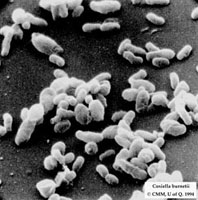
Micro means very small and biology is the study of living things, so microbiology is the study of very small living things normally too small tobe seen with the naked eye.
Activity The science of microbiology started with invention of the microscope and the English scientist, Robert Hooke, takes the credit for this. |
|
| Coxiella burnetii bacteria © 1994, The Centre for Microscopy and Microanalysis |
|
|
What sort of small, living things do microbiologists study? First we need to understand the classification of all living organisms. We also need to understand the fundamental characteristics of different types of organisms. As outlined in the classification, microbiology includes the study of:  bacteria(or
Eubacteria) bacteria(or
Eubacteria)
 fungi(or
Archaeobacteria)
fungi(or
Archaeobacteria)
 protists protists
 archaea
archaea algae
algae
Such organisms include: |
| All
microbes are bad for us, aren't they?
No. It is true that some microbes cause disease and others cause decay and damage to inanimate objects, but without microbes we would not be able to exist. Microbes are everywhere and the more we look the more we find, sometimes in the most unlikely of places. Our body is infested with microorganisms and most of them are essential for our survival. They assist in food digestion in our digestive system, for instance. Even microbes that cause decay are useful for they breakdown dead matter into simple chemicals, so the matter can be recycled and used by other - probably more complex - life forms. Without the decay process, the world would soon be covered in dead creatures and plants. Microbes have different functions for different purposes and to occupy different niches in the biology of the planet. They have evolved when and where they had the opportunity, without any moral imperative. But as humans, we find that some are useful to us and others are dangerous to us. So we view them as either good or bad. "Good" microorganisms include those that are necessary to maintain our environment, in a way that will support our existence. Then there are our very own microorganisms that our body uses as part of its internal defense system, to fight infection from outside. "Bad" microorganisms enter the body in a number of different ways, but most commonly by the respiratory and digestive system, or by damaged skin. They cause problems to the body because they destroy body tissue and release toxic substances. This upsets the normal running of the body, which has to divert energy to its internal defense system in order to fight the invader. Microorganisms that cause disease include:
For examples see Rainforest Diseases and the Bad Bug Book. |
How do microbes work? Firstly, it should be understood that all living things "work" in the same way at the most basic level. There are certain structures and functions that are common to all living organisms. Likewise all living things use similar chemical processes to work - this is known as organic chemistry. One chemical element above all others dominates organic chemistry - carbon. This has some unique properties that allow trillions of different chemicals to be made from a few chemical elements. An account of why carbon is the basis of life is shown here. Lets us look at some of the key structural and chemical components of living organisms in general and microbes in particular. The
Cell Two types of cell structure exist Prokaryote and Eukaryote. |
|
 Prokaryote structure Prokaryote cells lack a nucleus, and consist of a cell membrane in which several distinct components function. Typically these are: Chromosomes
- A coiled strand of DNA Prokaryotes often also possess flagella, which help them move. Eukaryote cells have additional internal components, notably a nucleus and mitochondria. Nucleus
- Contains the cell's DNA in threads of chromatin |
|
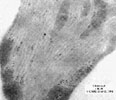 
Chloroplast Mitochondria © 1999 The Centre for Microscopy and Microanalysis |
![]()
Dictionary
of Cell Biology
The origins of Mitochodria and Chloroplasts
|
The DNA molecule is a double helix made of four types of nucleotide. These are aligned in a ladder formation, which is twisted like a screw. On opposite sides of the double helix are companion nucleotides. Adenine (A) and Thymine (T) are always located opposite other, and so are Guanine (G) and Cytosine (C). So, each strand of the double helix is a "mirror image" of the other. This is why A, T, G and C are the four letters associated with the genetic code. DNA is the "master copy" for all the instructions for the cells of the organism. The image shows the double helix structure of the DNA, which consists of two strands with the cross links at intervals joined be hydrogen bonds. There are ten crosslinks for every complete twist of the double strand. The lower image shows a section of the DNA helix, untwisted. It shows the main components of the strand: Sugars (pentagonal shapes), phosphates (spheres) and organic bases (A, C, G and T). To replicate, the DNA unzips along the center of the rungs of the ladder. The exposed free ends can then form two new DNA strands by allowing "partner" molecules to link at the exposed rungs. A can only pair with T, and C with G. Sometimes the replication process is not perfect. Stands break, or additional pieces of DNA become inserted, for instance. This is how mutations occur and evolution happens. |
|
RNA, ribonucleic acid, is a much smaller molecule than DNA, which copies the information and takes part in the process of protein synthesis in cells. It differs from DNA in that Uracil (U)replaces Thymine. Unlike DNA it can interact with other molecules, specifically ribosomes. The RNA copy of the DNA information is transcribed from the DNA template, this is known as transcription RNA, this is the copied message of the DNA. mRNA, messenger RNA, is a further copy of the RNA transcript which has been spliced and modified. It carries the information from the DNA which specifies an amino acid sequence of proteins. In a eukaryote it then moves out of the nucleus into the cytoplasm, where it attaches to the ribosome. In a prokaryote, which does not have a nucleus wall, the next process takes place on-site. mRNA is the new message of instructions from the DNA. tRNA, transfer RNA, is the adapter molecule which allows the mRNA nucleotide sequences to be translated into protein amino acid sequences. The tRNA anticodons link up to their corresponding codons of the mRNA, one at a time, as the mRNA moves through the ribosome. This is translation. tRNA is the receiver of the message. rRNA, ribosomal RNA, occurs with proteins to make up the ribosome which provides the site for translation to occur. Ribosomes can be be located in clusters, or as free individuals, depending upon the final purpose of the altered proteins. Ribosomes are the "factories" that use the message to make essential chemicals for a cell to function. Chromosomes and Genes are very long thread-like structures in the nucleus of eukaryotic cells, that carry the hereditary information of the cell. They contain a long length of double-stranded DNA coiled up - the famous Double Helix, along with some RNA and special proteins. Bacteria or prokaryotic cells, only have one chromosome each, which is not in the nucleus. Genes are units or factors of inheritance, each one being a length of DNA containing a particular instruction. For instance your eventual height is determined by a particular gene.
|
| Anaerobic respiration by contrast is a process whereby respiration takes place without oxygen. This occurs only in some groups of bacteria, living in anaerobic environments such as in soil and stagnant water. These strict (obligate) anaerobes use a substance other than oxygen - eg. sulfate, nitrate, carbonate - as the final electron acceptor. | |
|
(Above
left) Clostridium difficile:
anaerobic bacteria that can infects the large intestine.
© Neal Chamberlain
|
|
|
(Right)
Escherichia coli is glucose-fermenting Gram-negative bacteria
© 1994, The Centre for Microscopy and Microanalysis |
|
|
Facultative anaerobes, such
as yeasts and many bacteria, can
use either fermentation or aerobic respiration depending on the
availability of oxygen. In fermentation
the cell uses an organic molecule, such as ethanol or lactate, as
the electron acceptor. In the case of alcohol fermentation,
carbon-dioxide is released. Fermentation is less productive
than aerobic respiration as an energy source for cells.
(When animal muscle tissue is required to function without an adequate
oxygen supply there is a build up of lactic acid, which is an example
of lactic acid fermentation - this does not release carbon-dioxide.)
|
|
|
Comparison of relative efficiencies of different types of respiration: Aerobic respiration:
Anaerobic respiration with
ethanol formation (alcohol fermentation): Anaerobic respiration with
lactic acid formation (fermentation): |
For more information use the on-line glossaries for Glycolysis, ATP, Krebs Cycle and Calvin Cycle
Index
of Microbiolgy - Glossary
Microbiology
Glossar
|
Types
of association between and among life forms: Symbiotic - a relationship between two different species of organisms, living together in direct contact. Mutualistic - a relationship between two symbionts that is of mutual benefit, eg lichen (which is not an individual organism but the symbiosis of cyanobacteria and a fungus). Commensal - a symbiotic relationship which benefits the symbiont , but has no effect on the host, eg many of the bacteria living inside and on the surface of the human body. Parasitic - absorbing nutrients from a living organism the symbiont benefits, but harms the host - endoparasites live within the host, eg tapeworm; ectoparasites live outside the host, eg flea. |
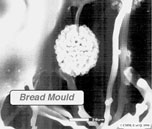 |
Saprophytic - absorbing nutrients from dead organic matter and decomposing it in the process, eg methanogens - an anaerobic sub-group of archaebacteria, used as decomposers for sewage treatment. Host & Symbiont: Host - participant
which is exploited by the symbiont.
|
| Bread mold spores © 1994, The Centre for Microscopy and Microanalysis |
 |
Photoautotrophs
are photosynthetic bacteria and cyanobacteria
which build
up carbon-dioxide and water into organic cell materials using energy
from sunlight. One product of this process is starch, which
is a storage or reserve form of carbon, which can be used when light
conditions are too poor to satisfy the immediate needs of the organism.
Photosynthetic bacteria have a substance called bacteriochlorophyll,
live at the bottom of lakes and pools, and use the hydrogen from
hydrogen-sulphide instead of from water, for the chemical process.
(The bacteriochlorophyll
pigment absorbs light in the extreme UV and infra-red parts of
the spectrum which is outside the range used by normal chlorophyll).
Purple
and green sulfur bacteria
use light, carbon-dioxide and hydrogen-sulphide from anaerobic decay,
to produce carbohydrate, sulfur and water. Cyanobacteria
live in fresh water, seas, soil and lichen, and use a plant-like
photosynthesis which releases oxygen as a by-product.
|
|
Photoheterotrophs use light, but obtain their carbon in organic form. Only certain types of prokaryotes can do this. The first life on Earth may have been of this type, using organic material such as amino acids not produced by biological activity. Chemoautotrophs include many bacteria. They use special chemical processes instead of sunlight to produce organic material from inorganic. Usually compounds other than sugar are oxidized for the chemical process. Colorless sulfur bacteria which live in decaying organic matter where they are unable to use sunlight, oxidize the hydrogen-sulphide given off, to form water and sulfur. Iron bacteria, which live in streams that run over iron-rich rocks, oxidize the iron salts. Hydrogen bacteria can oxidize hydrogen with the formation of water. Nitrifying bacteria are important for enriching soil with nitrogen in a form that can be used by plants. (See nitrification and denitrification). Chemoheterotrophs need organic molecules for providing energy and carbon. They are most commonly bacteria, but also protists, fungi, animals and some plants. Chemoheterotroph bacteria can be saprobes which absorb their nutrients from from dead organic matter, thus decomposing it, or mutualists and parasites, which absorb their nutrients from the body fluids of living hosts. E. coli is a chemoheterotroph. |
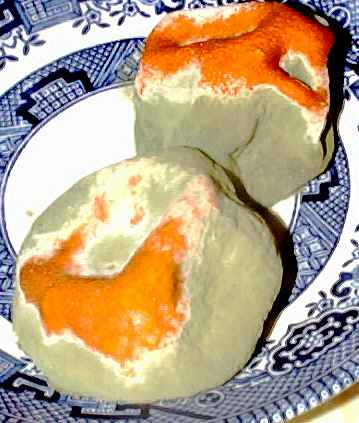 |
A saprophytic species of penicillium - mold on orange Nitrification and de-nitrification: Most of the ammonia from decayed animal and plant proteins in the soil is used by bacteria such as nitrosomonas and nitrococcus as an energy source. This activity oxidizes ammonia to nitrite whereupon other bacteria, nitrobacter, oxidize the nitrite to nitrate in a process called nitrification. Nitrate released from this process can be assimilated by plants through their roots and converted to organic form such as amino acids and proteins. Animals, however, can only assimilate organic nitrogen by eating other animals or plants. Some bacteria obtain the oxygen they need for metabolism from nitrate instead of oxygen. This results in the denitrification process, whereby some nitrate is converted back to nitrogen and returned to the atmosphere. |
|
The Food Chain or Food Web: is the process by which biomass is recycled. This involves the movement or cycling of organic chemicals through the environment, ie the movement of carbon, nitrogen, oxygen and water, through plants, animals, fungi, bacteria, etc by respiration and metabolism. For the processes involved, see Cycling Chemicals and Rainforest Ecology
|
|
Nanobacteria
filaments x35000 Microbes are extremely small but how small? They are so small that we cannot normally see them. You could fit many thousands on this full stop . Let us consider a typical bacterium. How big is it and what would it weigh? It would be something like 0.003 mm long and it would weigh 0.000000000001 grams Viruses are even smaller and recently nanobacteria a hundred times smaller than common bacteria, have been found. At the other end of the scale, giant bacteria are known. One, Epulopiscium fishelsoni is 0.06 mm long and 0.008 mm wide. Now visit the Size comparison page.
|
|
We use microscopes to see individual microorganisms, but it is possible to see colonies with the naked eye. Yeasts and molds are easy to see, as are the matted strands of algae. But in such instances you will be looking at thousands of individuals. How to see microbes. It is possible to detect individual microbes with the naked eye by employing a little trick. Look at a well-lit blank space - the sky or a white wall, for instance. Close one eye and partly close the other. De-focus and you should be able to see faint stringy strands on the surface of the eye that look like beads. Some of these are almost certainly bacteria such as streptococci. |
![]()
Microscopes
QX3
Computer Microscope
Microscapes
Space Station Biomedical
Lab
Go
to
Home
| Space Station
| Mars | Rainforest
© 1999 Satellite Events Enterprises Inc.



 DNA,
deoxyribonucleic acid,
is a complex molecule containing instructions for all the functions
of the cells of an organism, its "genetic information". It
replicates itself by separating its two interwoven strands (the
helix) like a zip fastener and attracting free nucleotides (simpler
molecules of nucleic acid) in the same order as the original.
DNA,
deoxyribonucleic acid,
is a complex molecule containing instructions for all the functions
of the cells of an organism, its "genetic information". It
replicates itself by separating its two interwoven strands (the
helix) like a zip fastener and attracting free nucleotides (simpler
molecules of nucleic acid) in the same order as the original.
